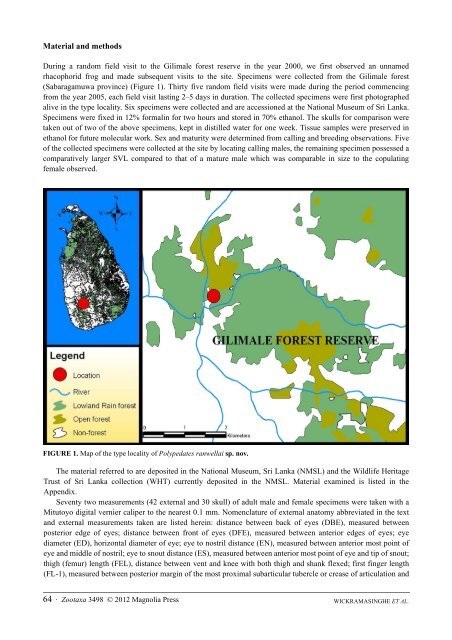Identification of Novel Species by Herpetological Foundation of Sri Lanka in Collaboration with Dilmah Conservation
Dilmah Conservation in collaboration with Herpetological Foundation of Sri Lanka has implemented a project on identification of new species of Herpetofauna, which will generate scientific evidence on their existence and promote conservation. This is the article published in Zootaxa Journal on the first new species identified as result of this research project – a species of Polypedates Tschudi …
Dilmah Conservation in collaboration with Herpetological Foundation of Sri Lanka has implemented a project on identification of new species of Herpetofauna, which will generate scientific evidence on their existence and promote conservation. This is the article published in Zootaxa Journal on the first new species identified as result of this research project – a species of Polypedates Tschudi …
You also want an ePaper? Increase the reach of your titles
YUMPU automatically turns print PDFs into web optimized ePapers that Google loves.
Material and methods<br />
TERMS OF USE<br />
This pdf is provided <strong>by</strong> Magnolia Press for private/research use.<br />
Commercial sale or deposition <strong>in</strong> a public library or website is prohibited.<br />
Dur<strong>in</strong>g a random field visit to the Gilimale forest reserve <strong>in</strong> the year 2000, we first observed an unnamed<br />
rhacophorid frog and made subsequent visits to the site. Specimens were collected from the Gilimale forest<br />
(Sabaragamuwa prov<strong>in</strong>ce) (Figure 1). Thirty five random field visits were made dur<strong>in</strong>g the period commenc<strong>in</strong>g<br />
from the year 2005, each field visit last<strong>in</strong>g 2–5 days <strong>in</strong> duration. The collected specimens were first photographed<br />
alive <strong>in</strong> the type locality. Six specimens were collected and are accessioned at the National Museum <strong>of</strong> <strong>Sri</strong> <strong>Lanka</strong>.<br />
Specimens were fixed <strong>in</strong> 12% formal<strong>in</strong> for two hours and stored <strong>in</strong> 70% ethanol. The skulls for comparison were<br />
taken out <strong>of</strong> two <strong>of</strong> the above specimens, kept <strong>in</strong> distilled water for one week. Tissue samples were preserved <strong>in</strong><br />
ethanol for future molecular work. Sex and maturity were determ<strong>in</strong>ed from call<strong>in</strong>g and breed<strong>in</strong>g observations. Five<br />
<strong>of</strong> the collected specimens were collected at the site <strong>by</strong> locat<strong>in</strong>g call<strong>in</strong>g males, the rema<strong>in</strong><strong>in</strong>g specimen possessed a<br />
comparatively larger SVL compared to that <strong>of</strong> a mature male which was comparable <strong>in</strong> size to the copulat<strong>in</strong>g<br />
female observed.<br />
FIGURE 1. Map <strong>of</strong> the type locality <strong>of</strong> Polypedates ranwellai sp. nov.<br />
The material referred to are deposited <strong>in</strong> the National Museum, <strong>Sri</strong> <strong>Lanka</strong> (NMSL) and the Wildlife Heritage<br />
Trust <strong>of</strong> <strong>Sri</strong> <strong>Lanka</strong> collection (WHT) currently deposited <strong>in</strong> the NMSL. Material exam<strong>in</strong>ed is listed <strong>in</strong> the<br />
Appendix.<br />
Seventy two measurements (42 external and 30 skull) <strong>of</strong> adult male and female specimens were taken <strong>with</strong> a<br />
Mitutoyo digital vernier caliper to the nearest 0.1 mm. Nomenclature <strong>of</strong> external anatomy abbreviated <strong>in</strong> the text<br />
and external measurements taken are listed here<strong>in</strong>: distance between back <strong>of</strong> eyes (DBE), measured between<br />
posterior edge <strong>of</strong> eyes; distance between front <strong>of</strong> eyes (DFE), measured between anterior edges <strong>of</strong> eyes; eye<br />
diameter (ED), horizontal diameter <strong>of</strong> eye; eye to nostril distance (EN), measured between anterior most po<strong>in</strong>t <strong>of</strong><br />
eye and middle <strong>of</strong> nostril; eye to snout distance (ES), measured between anterior most po<strong>in</strong>t <strong>of</strong> eye and tip <strong>of</strong> snout;<br />
thigh (femur) length (FEL), distance between vent and knee <strong>with</strong> both thigh and shank flexed; first f<strong>in</strong>ger length<br />
(FL-1), measured between posterior marg<strong>in</strong> <strong>of</strong> the most proximal subarticular tubercle or crease <strong>of</strong> articulation and<br />
64 · Zootaxa 3498 © 2012 Magnolia Press<br />
WICKRAMASINGHE ET AL.















